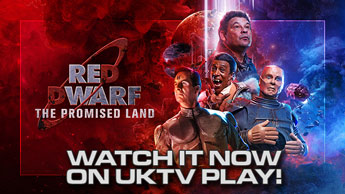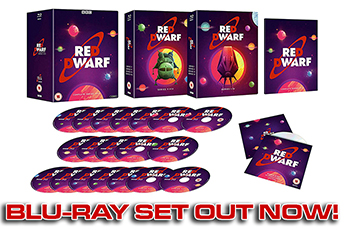Infinite Universes
Todd Downing brings you The Making of Red Dwarf - The Roleplaying Game.
26 November, 2004
Part One - The Early Years
The Time: Summer, 1993
The Place: The Gamut, a game and hobby store in Seattle, USA
We'd opened in July and were in the habit of running sci-fi & fantasy videos in the shop for ambience. In steady rotation were my faves, that crazy sci-fi britcom, Red Dwarf (series I-V). One day, in the midst of stocking the new comics, I looked up to see an emotionally altered Red Dwarf crew chasing a polymorph through the cargo decks. "Dwarf would make a pretty cool RPG," I thought, sure that a British publisher would have seen the same potential and have one in the works pronto.

Part Two - The Next Part
The Time: Summer, 2000
The Place: A small café in Seattle, USA
The Gamut had closed down in 1996, but some of the partners had stuck around to form a game publishing company called Deep7. While prepping our original fantasy RPG, Arrowflight, there came a call for ideas for a licensed game. "Red Dwarf," I said, but the idea was laughed off. There were approximately twelve thousand metric lorry loads of sci-fi properties available at the time, however they were all either too expensive or not distinctive enough. "Red Dwarf," I offered at a subsequent meeting, and waited for the laughter and shaking of heads. This time, the brush-off never came. I felt I'd waited for someone else to make a game out of one of my fave television shows for seven years, and since no one had by now, it was my turn to just step up and do it.
Over the next year, with hand puppets and a slide-show, I attempted to demonstrate the basic concept - we'd base the game around the premise of infinite dimensions and realities, a fundamental pillar of the Red Dwarf foundation. Players would be able to create characters based on the archetypes found in the show (mechanoids, holograms, evolved pets, and precious few humans, etc). We'd adapt our XPG game system, already proven to work with settings as diverse as film noir and pirates, and quite capable of supporting the ridiculous comedy of paramilitary Christmas elves in our Santa's Soldiers game. The mechanics were simple enough for newbies, yet robust enough to satisfy more experienced gamers. We fired off the proposal to Grant Naylor Productions, who put us in touch with IMC Licensing, the North American agency, and we were off and running.

Part Three - The Middle Bit
The Time: All of 2002
The Place: Deep7's office in Seattle, USA
With any new business relationship, there is a learning curve. Deep7 had its first license, and Grant Naylor had its first roleplaying game product. Educating most license holders as to the realities of the cottage adventure game industry can be an enormous headache; by contrast we found everyone at GNP to be warm, friendly and open. All except Andrew Ellard, who we found more trapezoidal, moist and slightly crunchy. We would find through trial and error that the default approvals system needed some tweaking to flow smoothly; by the time we released the A.I. Screen, it was not only smooth, but emitted a pleasant lavender fragrance.
Now that we had a project, a system and a design philosophy, we needed to get some hacks... er, talented professionals to fill in the blanks and work for a stupidly small pay rate. Fortunately, there are acres of them in the UK and America, and we set out to find our creative kin.

Mark Bruno was a longtime associate who had authored our film noir RPG called Mean Streets, and had contributed to the Dinosaur Planet and Seventh Seal game lines as a writer and copy editor. He is also a rabid Dwarfer, which meant I would never be able to NOT assign him work on this game, at least if I ever wanted to see my robotic goldfish alive again (curse you, Mark Bruno). I gave him the Hardware section.
John Sullivan (no, not the creator of Only Fools and Horses) had authored some pretty pivotal material in our Bloode Island line, and regularly wrote reviews for SciFi Weekly. I knew I could count on his warped sense of humour to cover the Worlds section. Later, John was to receive critical acclaim for his short story "Relapse" in Eden Studios' zombie horror anthology The Book of Final Flesh.
Andrew Kenrick was our token Brit on the project - not because there weren't any good British game designers, but because he was the only good British game designer who bothered to answer our calls. Andrew has done work for Mongoose Publishing, Spectre Press, Bastion Press and Politically Incorrect Games, and operates his own publishing imprint, SteamPower Publishing. And he has actually touched Chlöe Annett. He got the Medibay section, since he knows a lot about being sick.
Lee Hammock had a track record writing for Holistic Design and Bastion Press, and was fresh off the Farscape RPG (which was, incidentally, another license we'd considered). He came recommended by my brother Gavin, who also worked on Farscape. Lee got the Creatures to do, since he felt a close connection to the Mutton Vindaloo Beast.
Gavin Downing is less a BENEFICIARY of nepotism, and more a VICTIM of it. Gavin had been writing material for many of our game lines, was a co-creator of Arrowflight, and helped overhaul Santa's Soldiers for the second edition - and he was nearly as hardcore a Dwarf fan as I was. It fell to Gav to help develop the character archetypes and fill in here and there.
Allan McComas is a grossly talented, underrated and underused writer, whose association dates back to the first Arrowflight game testing in the early '90s. Another mad Dwarfer, he contributed the seeds for the Scenario Generator.
Samantha Downing, far from being either a victim or beneficiary of nepotism, is simply an arse-kicking editor and layout diva. She got a writing credit due to a certain amount of re-writing and finessing beyond her straight editorial work. Without Sam, the game would not have been produced.
I selected me to write everything else, because I'm quite probably insane, and besides, it was bloody well my idea - so there.
Where art was concerned, I nabbed Seattle comic artist Steve Hartley, who did the excellent character archetypes. BBC effects artist Mike Tucker graciously let us use his SS Esperanto art, and my 3D compadre Joolz De Puma hammered out some great Starbug cutaways, based on the set floorplan given us by GNP and viewing the tapes until our eyes bled. I ponied up the mechanical drawings (guns, equipment) and assembled those fake ads you see throughout the book.

Part Four - You're Not Even Reading This, Are You?
The Time: Still 2002
The Place: Heck if I can tell at this point.
So once we had the manuscript together, it was time to playtest. And the fine folks at GNP poured over said manuscript for content approval. At the same time, some advance buzz was starting to pop up on some gaming websites. Some of it was hopeful, some of it less than flattering. We heard comments like, "a bunch of Yanks will never be able to pull off the flavour of that show!" and, "What a terrible premise for an RPG - there's only six characters lost in space and they never leave the ship!" I wondered if they'd been watching the same Red Dwarf we had.
In the midst of playtesting, revising content, and laying out a 2 to 4 colour hardcover book (something we'd never attempted previously), we found ourselves headed at mach four toward a cinderblock wall marked MURPHY'S LAW... Samantha was diagnosed with a rare and aggressive form of cancer. There's really not much I could say that would be funny, except perhaps, "bugger". It threw our lives and our business into chaos - my wife and business partner was being threatened with the biological Sword of Damocles. Fortunately, Robert Llewellyn gave us a most excellent back cover blurb to use, giving us the thumbs up from an actual cast member. The folks at GNP and IMC kept encouraging us to move ahead at our own pace.

Red Dwarf - The Roleplaying Game was supposed to come out in October '02 for the holiday season, and we took some heat from fans who didn't know what had happened to Samantha. We spent most of the holidays that year in and out of hospital, getting her infused with nasty drugs and promising the fans as best we could that the book would be out soon. Once they discovered the story behind the delay, their support was unanimous, and we sent the book to our Canadian printer just shy of the New Year. Come February, roleplaying games would never be the same...
Part Five: Yeah, Baby!
The Time: February (and beyond) 2003
The Place: North America
Red Dwarf - The Roleplaying Game was released in February 2003 to stores across the US and Canada. Fans went wild. We were equalling and surpassing sales of some of the more mass-market games, driven by print advertising and solid word-of-mouth. The respected gaming site Pyramid said the work was "remarkable... a benchmark by which similar efforts should be judged". SciFi Weekly gave us an 'A' grade. The proof was indeed in the pudding.
The "two" in the "one-two punch" that was the Red Dwarf RPG came in the form of the A.I. Screen & Extra Bits Book. Gavin & I had put together a Roman orgy of useful supplemental material, making the product a step away from the scenario-in-a-can gamemaster screen. We stole wholeheartedly from "Stoke Me A Clipper" and developed the optional War World setting, incorporating Nazis, rocketpants, Ace Rimmer and a supercomputer run by Hitler's brain. Game screens never sell as well as the core books they support, but it bolstered our first few months and made the game the top selling RPG product for our fulfilment house, Impressions Advertising & Marketing.

The summer of 2003 was extremely busy, between the release of several non-Dwarf products, a trip to Gen Con in Indianapolis, and Samantha's cancer treatments. We'd originally set a target of November to get the Series Sourcebook out the door, but found that Sam's health (or lack thereof) had knocked our production schedule off as much as eight months or more. We got the team together, this time consisting of John Sullivan (series I & II), Andrew Kenrick (series VII & VIII), and yours truly (series V ≈ VI). For series III & IV, we brought in a newbie to the team, Eddy Webb, who (aside from being absolutely fruitbaskets mad for Dwarf) had done some brilliant design on the hit indie RPG Cartoon Action Hour. Gavin returned to stat out the NPCs - any bad puns are his fault.
We broke down each episode into its playable components, and went nuts. Steve & I banged out the drawings and graphics, and I put together some more of those absolutely HILARIOUS fake ads. Hattie Hayridge waived even the most modest writing fee and contributed a lovely foreword - what a sweetie she is! [Note to self: send Hattie enormous bag of peanut M&Ms.] Finally able to return to a light workload, Sam edited the book and laid it out in record time. We went through approvals, sent it to press, and let the die-hard fans know their wait was over. And here it is - eleven months late, but who's counting?

We'd always intended the Red Dwarf RPG line to be pretty self-contained, relying on the fanbase and their creative use of the tools we published to keep the game alive. Many RPG lines, especially in the age of the d20 market glut, require supplement after supplement, each selling more poorly than the last. The line sometimes collapses under its own sheer weight, and that's something we wanted to avoid at all costs. With the release of the Series Sourcebook, players now have a trilogy of works on which to draw for their campaigns. Dwarfers now have everything they need to create characters, monsters, items, scenarios and introduce classic canon characters and guests from every episode of the show. And as always, rubbing the books on your skin will make you irresistible to the desired gender.*
There is probably still Red Dwarf gaming material somewhere deep down in my unmentionable bits, ready to be mined at some point. I'd like to do a book of AR suite adventures. Some of my most favourite game moments have occurred when Mexican wrestlers invade a western AR scenario, or Stabby the Angry Gnome gets loose from the storybook AR game and goes on a rampage in the cargo decks. And of course we'd love to do the movie sourcebook. But for now, we feel blessed to have the opportunity to work with such great folks at GNP, to have made three entertaining and well-received Red Dwarf products, and to be celebrating two years of cancer survival for Sam, despite a rather grim prognosis at the outset and no cure in the immediate future. And with an enlarged sales territory that includes the UK, we can now bring the game to the home crowd. We're literally a mom & pop game design studio who got the opportunity of a lifetime - to make the Red Dwarf RPG we always wanted to play, as fans. Our fellow Dwarf fans have responded favourably, so I guess we succeeded on that count.

* Rubbing the books on your body has not been scientifically proven to increase sexual desirability, and in fact has been known to cause depression, hair loss and involuntary twitching in laboratory animals.














